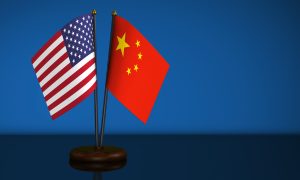
China and the United States appear to be restarting dialogue between their militaries, despite continuing disputes over Beijing’s claims to Taiwan and the South China Sea.
The U.S. confirmed on Thursday that it plans to send Cynthia Carras, principal director for China, Taiwan, and Mongolia, to represent the U.S. Defense Department at the Xiangshan Forum in Beijing this month.
The international gathering hosted by the Chinese Defense Ministry aims to discuss security cooperation and raise China’s status as a global power and rival to the United States and its Asian allies, including Japan and South Korea.
China froze military exchanges in August 2022, after then-Speaker of the House of Representatives Nancy Pelosi visited self-governing Taiwan, which China claims as its own territory.
In one of the most notable incidents, Chinese defense officials refused to answer a call in February from U.S. Defense Secretary Lloyd Austin following the shooting down of a suspected Chinese spy balloon that had flown across North America, sparking a major diplomatic crisis between the sides that had already seen ties plummet to a historical low.
In a statement, the Pentagon said it “welcomes the opportunity to engage with [People’s Liberation Army] representatives at the Xiangshan Forum on ensuring open and reliable lines of communication, ensuring crisis communications channels, reducing strategic and operational risk, and avoiding misperceptions.”
Earlier on Thursday, Chinese Defense Ministry spokesperson Colonel Wu Qian told reporters that “China attaches great importance to the development of military-to-military relations between China and the United States.”
The annual Xiangshan Forum is scheduled for October 29-31.
“As we see it, the ranks of the personnel taking part in the exchanges are not the most important. What is more important are the contents of the exchanges,” Wu said.
The comments came as China’s top diplomat Wang Yi departed for Washington to meet with Secretary of State Antony Blinken and National Security Advisor Jake Sullivan. That follows a series of high-level visits from the United States to China in recent months. In the latest sign of thawing ties, Blinken met Chinese President Xi Jinping, the leader of the ruling Communist Party, in Beijing in June.
China had attributed its refusal to restart military communications to sanctions imposed by Washington on former Defense Minister Li Shangfu. However, on Tuesday China announced the removal of Li as defense minister without giving any explanation or naming a replacement.
In answer to a reporter’s question on Li’s removal, Wu said: “I suggest you pay attention to the release of authoritative information.”
Former Foreign Minister Qin Gang was also removed from office this year under circumstances that the government has yet to explain.
China’s highly opaque political system lends itself to heavy speculation around the reasons why officials are removed, mostly focusing on possible corruption, political differences, or violations of an unwritten code of personal conduct.
China on Thursday also released video it said showed a close encounter between the Chinese navy and the USS Ralph Johnson, claiming the American destroyer harassed the PLA Navy’s latest-generation type 052 destroyer Guilin while it was undergoing routine training in the South China Sea on August 19.
China claimed the USS Ralph Johnson took a sharp turn and accelerated, crossing the bow of the Chinese ship near the disputed Paracel Islands.
“What the U.S. side wants is to threaten China’s national security with unrestricted provocation and nuisance against China,” Wu said, adding that the “Chinese military is always on high alert and will take all necessary measure to firmly safeguard the sovereignty, security and maritime rights of the nation.”
China claims almost all of the strategically vital South China Sea as its own territory. Neighboring countries, including U.S. ally the Philippines, Vietnam, Malaysia, Brunei, and Taiwan also claim territory in the region.
No comments:
Post a Comment